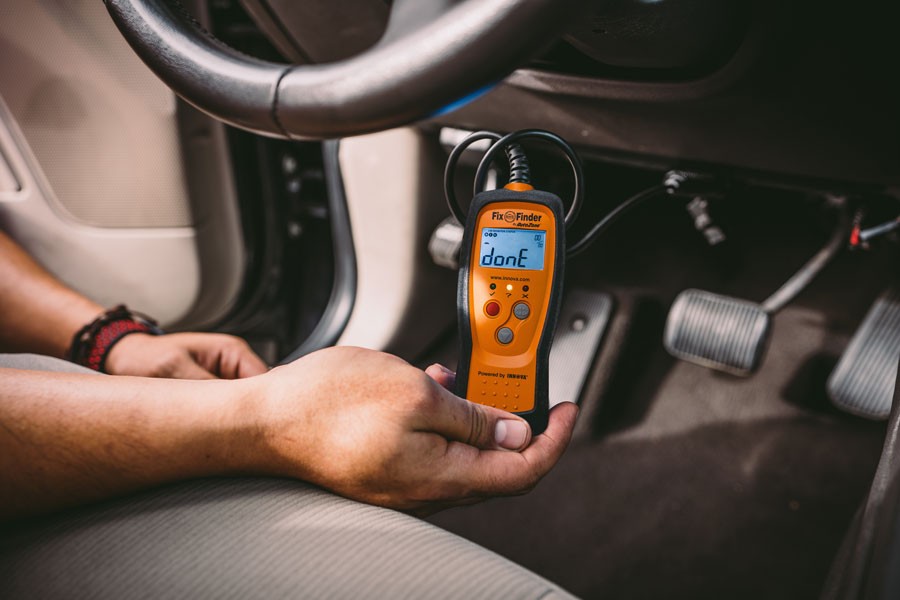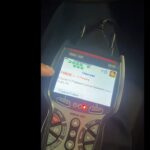Understanding your vehicle’s health is now easier than ever with an OBDII code reader. This essential tool allows car owners and enthusiasts to tap into their car’s computer and diagnose potential issues right from their driveway. This Obdii Code Reader Manual will guide you through the process of connecting, using, and understanding the information provided by your OBDII scanner, empowering you to take control of your car’s maintenance.
Connecting Your OBDII Code Reader: A Step-by-Step Guide
Locating the OBDII port is the first step in accessing your vehicle’s diagnostic data. In almost every car and light truck manufactured since 1996, you’ll find a standardized 16-pin port, known as the OBDII (On-Board Diagnostics II) port. This port is typically located within two feet of the steering wheel, most commonly under the dashboard on the driver’s side. While the under-dash location is standard, in some models, it might be found in the center console or even under the passenger side dashboard.
The OBDII port features a female connector with a unique trapezoidal shape. Connecting your OBDII reader is straightforward due to its keyed design, ensuring it only fits correctly in one orientation. To connect, simply align the male connector of your code reader with the OBDII port, matching the trapezoidal shapes. Then, gently but firmly push the two connectors together until they are securely seated. A slight wiggle may be needed to ensure a complete connection.
For a successful connection and reading, follow these steps in order:
- Turn off the ignition: Ensure your vehicle’s ignition is completely off before you begin.
- Connect the scan tool: Plug your OBDII scanner into the diagnostic port.
- Turn the ignition to the ‘ON’ position (engine off): Turn the key or press the start button to switch the ignition to the ‘ON’ position. This powers up the car’s electrical systems without starting the engine.
- Power up the scan tool: In most cases, the OBDII port will supply power to your scan tool automatically.
- Wait for boot-up: Allow your OBDII scanner to complete its boot sequence. This may take a few moments.
Once powered on, your OBDII scanner may prompt you for additional vehicle information such as engine size, Vehicle Identification Number (VIN), or instructions to start the engine. Follow the on-screen prompts to proceed.
Navigating the OBDII Scanner Menu: Understanding the Options
After your OBDII scanner has successfully booted up and connected to your vehicle, you’ll be presented with a menu. The options available will vary depending on the type of scanner you are using, ranging from basic code readers to more advanced professional-grade tools. However, common menu options you can expect to find include:
- Read Codes: This is the primary function for diagnosing issues. Selecting “Read Codes” will instruct the scanner to retrieve and display any stored or pending Diagnostic Trouble Codes (DTCs). These codes are numerical identifiers for specific faults detected by your car’s computer system. Along with the code, some scanners might also provide a brief description of the fault. If multiple codes are present, the scanner will typically scroll through each one.
- Erase Codes: This option allows you to clear or reset diagnostic trouble codes from your vehicle’s computer memory. When you select “Erase Codes,” the scanner will usually ask for confirmation to prevent accidental code clearing. It’s important to note that erasing codes doesn’t fix the underlying problem that triggered the code; it only clears the record of it. If the issue persists, the code will likely reappear.
- Live Data: For scanners equipped with this feature, “Live Data” enables you to monitor real-time sensor readings from various systems within your vehicle. This is incredibly useful for diagnosing intermittent problems or observing sensor behavior under different operating conditions. You can scroll through lists of parameters like engine temperature, RPM, oxygen sensor readings, and more, to see if they are within expected ranges.
- Freeze Frame: “Freeze Frame” data captures a snapshot of crucial sensor parameters at the exact moment a DTC was set. This information provides valuable context for diagnosing the fault, as it shows the conditions under which the problem occurred. Freeze frame data can include parameters like engine speed, engine load, fuel trim, and coolant temperature at the time of the fault.
- Vehicle Info: This section displays basic information about your vehicle, often retrieved directly from the car’s computer. This can include the VIN, calibration IDs, and other vehicle-specific data.
- I/M Readiness: “I/M Readiness” stands for Inspection and Maintenance Readiness. This function checks the status of various emissions-related systems to determine if your vehicle is ready for a smog check or emissions test. It indicates whether the onboard diagnostic system has completed testing of these systems.
Most OBDII scanners, even Bluetooth or Wi-Fi enabled versions controlled via smartphone apps, will have physical buttons for navigation. Arrow buttons are used to scroll through menu options, a select or enter button confirms your choice, and often a back button is included to return to the previous menu. Familiarize yourself with your scanner’s button layout for easy navigation.
Decoding OBDII Trouble Codes: Understanding the Language of Your Car
 OBD-II scanner displaying diagnostic trouble codes.
OBD-II scanner displaying diagnostic trouble codes.
When you choose “Read Codes” on your OBDII scanner, it will display a series of diagnostic trouble codes. These codes are standardized across the automotive industry to ensure consistency in fault reporting. A DTC always follows a specific format: one letter followed by four numerical digits, for example, P0301.
The initial letter of the code categorizes the system where the fault has been detected:
- P (Powertrain): Relates to the engine, transmission, fuel system, and emissions control systems. These are the most common types of codes encountered.
- B (Body): Indicates issues within body control systems, such as airbags, power windows, interior lighting, and other cabin-related electronics.
- C (Chassis): Points to problems in chassis systems, including anti-lock brakes (ABS), traction control, suspension, and power steering.
- U (Network or Undefined): Signifies communication or network-related issues within the vehicle’s computer network.
The numerical digits following the letter provide further details about the specific fault. The first digit after the letter is either a ‘0’ or a ‘1’:
- 0: Indicates a generic OBDII code. These codes are standardized by the Society of Automotive Engineers (SAE) and are common across all vehicle manufacturers.
- 1: Signifies a manufacturer-specific code. These codes are defined by the specific car manufacturer and may relate to systems or issues unique to that brand or model.
The subsequent digits further pinpoint the system and the nature of the fault. The third digit (second number) specifies the subsystem affected:
- 1: Fuel and air metering system.
- 2: Fuel and air metering – injector circuit.
- 3: Ignition system or misfire.
- 4: Auxiliary emission controls.
- 5: Vehicle speed control or idle control system.
- 7, 8, 9: Transmission-related codes.
- A, B, C: Hybrid-specific codes.
The final two digits provide even finer detail, identifying the specific component or circuit that is malfunctioning. There are hundreds of possible combinations, each with a specific description.
Let’s revisit our example code, P0301. Based on the code structure:
- P: Powertrain system.
- 0: Generic OBDII code.
- 3: Ignition system or misfire.
- 01: Specific misfire fault related to cylinder #1.
Therefore, P0301 indicates a generic powertrain code for a cylinder #1 misfire.
Saving Money with an OBDII Code Reader: DIY Diagnostics and Repairs
Owning an OBDII code reader can lead to significant savings on car repairs in several ways.
Firstly, when your “Check Engine” light illuminates or you experience performance issues, an OBDII scan provides an immediate clue to the potential problem. While it might not pinpoint the exact cause, it’s a crucial first step in the diagnostic process, directing you towards the affected system or component.
Secondly, the I/M Readiness test feature can save you from failing a smog check. By running this test before your official inspection, you can identify potential emissions-related faults that could cause you to fail, allowing you to address them beforehand.
Furthermore, for those inclined to DIY car repairs, an OBDII scanner can empower you to diagnose and fix problems yourself. For example, if a scan reveals a P0138 code indicating a high voltage issue with the bank 1 sensor 2 oxygen sensor, you can research this code, likely find that replacing the oxygen sensor is the solution, and perform the repair yourself. After replacing the sensor, you can use your OBDII scanner to clear the code and verify the repair.
AutoZone offers a wide selection of OBDII scanners to suit various needs and budgets, empowering you to expand your DIY automotive capabilities. Additionally, consider utilizing AutoZone’s Loan-A-Tool program, which allows you to borrow certain diagnostic tools, including OBDII scanners, at no cost, making car diagnostics even more accessible.
OBDII Code Reader Manual: Frequently Asked Questions
How do you use an OBD II scanner?
Simply plug the scan tool connector into the OBDII port under your dashboard, turn your vehicle’s ignition to the ‘ON’ position (engine off), and follow the on-screen instructions provided by your scanner.
Does the car have to be running to use an OBD2 scanner?
No, in most cases, you can read trouble codes and access diagnostic information with the ignition in the ‘ON’ position without the engine running.
How do I read my OBD scanner?
Navigate to the “Read Codes” option on your scanner’s menu. The scanner will display any active or pending diagnostic trouble codes. Record these codes, noting the letter and numbers, to understand the system and specific fault indicated.
Can you plug in an OBD scanner while the car is running?
While technically possible, it’s generally not recommended to plug in or unplug an OBD scanner while the engine is running. It’s best practice to turn the ignition off before connecting or disconnecting the scanner. If you plug it in while running, you may need to cycle the ignition off and back on to initiate the diagnostic test properly.

